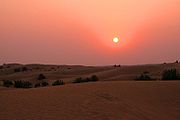With 120–140 rainy days per year, Kerala has a wet and maritime tropical climate influenced by the seasonal heavy rains of the southwest summer monsoon. In eastern Kerala, a drier tropical wet and dry climate prevails. Kerala's rainfall averages 3,107 mm annually. Some of Kerala's drier lowland regions average only 1,250 mm; the mountains of eastern Idukki district receive more than 5,000 mm of orographic precipitation, the highest in the state
In summers, most of Kerala is prone to gale force winds, storm surges, cyclone-related torrential downpours, occasional droughts, and rises in sea level and storm activity resulting from global warming. Daily average high 36.7 °C; low 19.8 °C. Mean annual temperatures range from 25.0–27.5 °C in the coastal lowlands to 20.0–22.5 °C in the eastern highlands.
Seasons
- Winter, occurring between January thru March. The year's coldest months are December and January, when temperatures average around 10–15 °C (50–59 °F) in the northwest; temperatures rise as one proceeds towards the equator, peaking around 20–25 °C (68–77 °F) in mainland India's southeast
- Summer or pre-monsoon season, lasting from March to June (April to July in northwestern India). In western and southern regions, the hottest month is April; for northern regions, May is the hottest month. Temperatures average around 32–40 °C (90–104 °F) in most of the interior.
- Monsoon or rainy season, lasting from June to September. The season is dominated by the humid southwest summer monsoon, which slowly sweeps across the country beginning in late May or early June. Monsoon rains begin to recede from North India at the beginning of October.
- Post-monsoon season, lasting from October to December. South India typically receives more precipitation. Monsoon rains begin to recede from North India at the beginning of October. In northwestern India, October and November are usually cloudless. Parts of the country experience the dry northeast monsoon.
|



